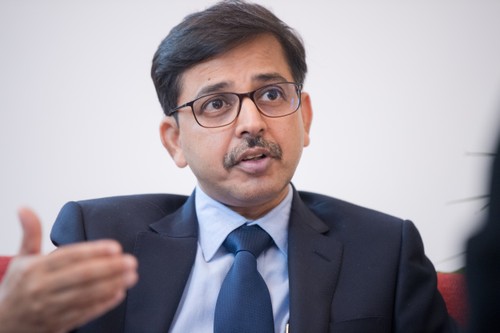Reporter: Economic and trade cooperation is one of the main pillars of the Vietnam-India Comprehensive Strategic Partnership. Two-way trade hit 11.3 billion USD in 2019 and the two countries target 15 billion USD this year. These figures are relatively modest compared to Vietnam’s trade with China, the US, and the EU. What should be done to improve trade ties between Vietnam and India?
Ambassador Pranay Verma: COVID-19 has pushed us into rethinking the way we engage with each other and it is there that new opportunities emerge. Given our supply chain as well as demand disruptions in the wake of COVID-19, we are all exploring new supply chains and new partnerships. I think this is an opportunity for us to actually expand our trading engagement by identifying new supply chains located in each other’s country.
We also need to do more to build connectivity – connectivity in physical sense but also in digital domain which will become increasingly important with the COVID pandemic continuing to be around us. We have to learn to apply technology more and more in conducting business, including through on-line platforms.
We also need to set new and ambitious targets and back it up with a strong plan of action so that each side is clear about what to achieve and how to achieve. That is a practical way to move forward.
At the same time, we also need to upgrade our regional trading architecture. For India and Vietnam, it is the ASEAN-India Trade in Goods Agreement (AITIGA). This architecture is of 2009 vintage and has never been reviewed. We really hope that Vietnam as the Chair of ASEAN can help in launching the review of AITIGA at the earliest, since that is an important foundation for taking forward our trade engagement.
 Indian Ambassador to Vietnam Pranay Verma. (Photo: VOV) Indian Ambassador to Vietnam Pranay Verma. (Photo: VOV) |
Reporter: India has been extending support to ASEAN countries in the space science. Could you please tell us more about particular initiatives for Vietnam as part of the India-ASEAN Space Project?
Ambassador Pranay Verma: There is a wide range of developmental applications of space technology, such as remote sensing, weather forecasting, resource exploration, forestry, agriculture, urban planning, communications, navigation, tele-medicine, tele-education and so on. With Vietnam, we have been able to capture all these in a Framework Agreement for Exploitation and Use of Outer Space for Peaceful Purposes that was signed in 2016. We are already engaged with Vietnam in capacity building and training programmes related to space applications. We would like to scale up these engagements further to make space technology an important pillar of our development partnership.
With regard to the ASEAN-India space cooperation with particular reference to Vietnam, we are in the process of setting up a Tracking and Data Reception Station and Data Processing Facility in Binh Duong, as one of ASEAN-India cooperation projects. From the Indian side, Indian Space Research Organization (ISRO) and from the Vietnamese side, the National Remote Sensing Department under the Ministry of Natural Resources & Environment are collaborating on this.
Reporter: Yoga has been warmly welcomed in Vietnam over recent years. Many yoga instructors from India have come to work in Vietnam. In your opinion, what Vietnam and India should do to boost people-to-people exchanges in addition to “yoga diplomacy”?
Ambassador Pranay Verma: We are very happy that the International Day of Yoga right since its inception in 2015 is celebrated in Vietnam every year with great fervor. The widespread popularity of Yoga across the length and breadth of Vietnam also reflects our mutual cultural affinity.
Among other ways in which we can promote people-to-people exchanges between our two countries, I would suggest promotion of film and television series. India’s Bollywood is a globally recognized brand. It is time we bring more Indian films to Vietnam, and maybe find a way to get Indian films to be shot at some of Vietnam’s scenic locations. This will hugely popularize Vietnam in India and give a boost to tourism. There are some Indian TV series being aired by Vietnam’s TV channels that are quite popular. We need to do more.
Also, Buddhism as our shared heritage can help us boost tourism, and academic and scholarly exchanges. Similarly, Vietnam’s Cham culture carries great symbolism of our historical and cultural association that can attract popular attention. Lastly, in India and Vietnam, we both have our own pop cultures that appeal to the youth. We need to find a way to use that pop culture to connect our youths.
Reporter: Thank you for granting VOV this interview!